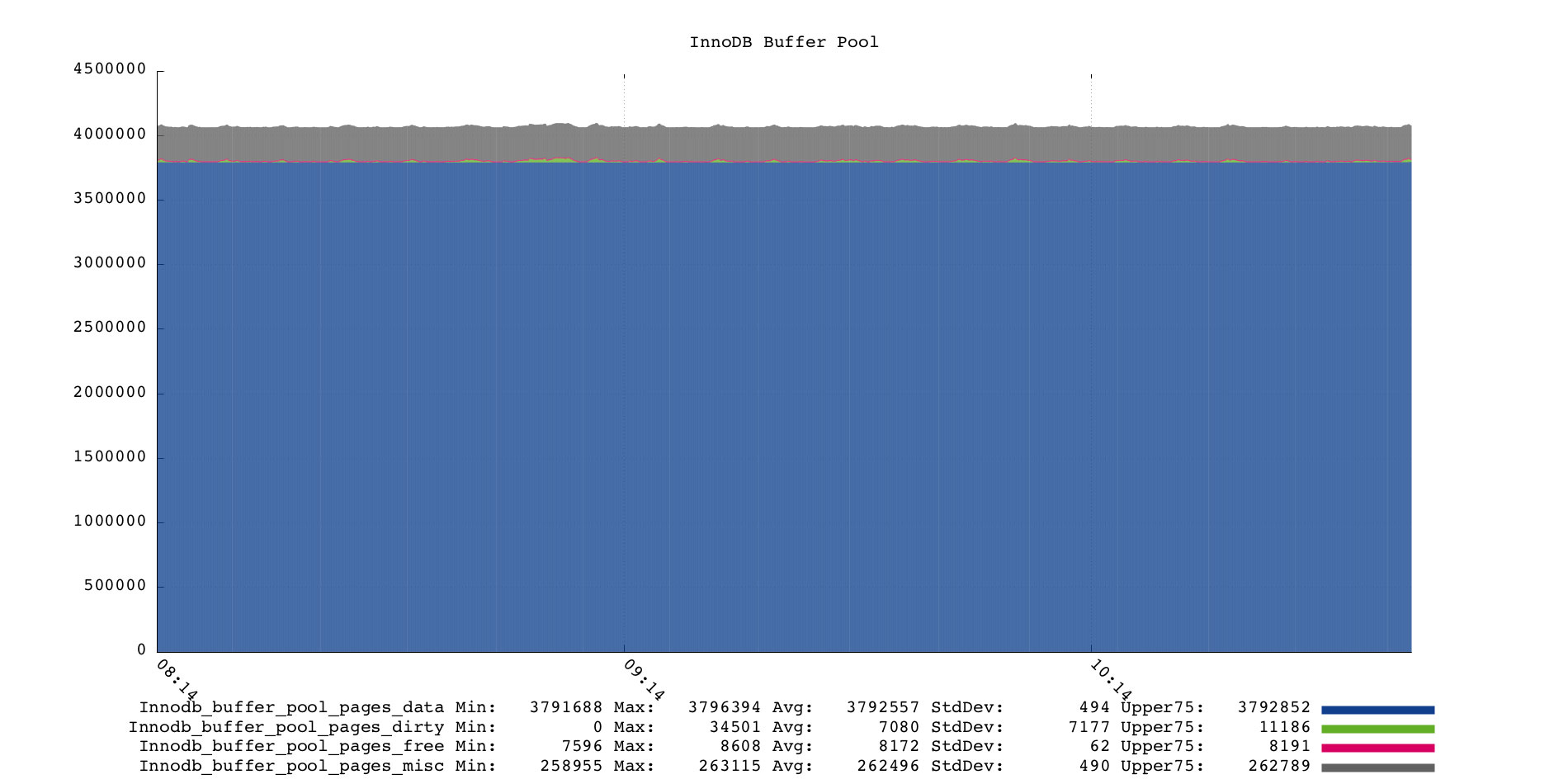理解innodb buffer pool
innodb buffer pool有几个目的:
-
缓存数据--众所周知,这个占了buffer pool的大半空间
-
缓存目录--数据字典
-
insert buffer
-
排序的内部结构--比如自适应hash的结构或者一些行锁
1.查看表的数据和索引使用情况?
SELECT engine, count(*) as TABLES,
concat(round(sum(table_rows)/1000000,2),'M') rows,
concat(round(sum(data_length)/(1024*1024*1024),2),'G') DATA,
concat(round(sum(index_length)/(1024*1024*1024),2),'G') idx,
concat(round(sum(data_length+index_length)/(1024*1024*1024),2),'G') total_size,
round(sum(index_length)/sum(data_length),2) idxfrac
FROM information_schema.TABLES
WHERE table_schema not in ('mysql', 'performance_schema', 'information_schema','test')
GROUP BY engine ORDER BY sum(data_length+index_length) DESC LIMIT 10;
得到的结果:
|
1
2
3
4
5
6
7
8
9
10
11
12
13
|
+--------+--------+----------+---------+--------+------------+---------+| engine | TABLES | rows | DATA | idx | total_size | idxfrac |+--------+--------+----------+---------+--------+------------+---------+| InnoDB | 71608 | 1644.51M | 130.79G | 82.76G | 213.55G | 0.63 |+--------+--------+----------+---------+--------+------------+---------+idxfrac这个值越低越好,举个例子,表里只有一个唯一索引的数据如下:+--------+--------+----------+---------+--------+------------+---------+| engine | TABLES | rows | DATA | idx | total_size | idxfrac |+--------+--------+----------+---------+--------+------------+---------+| InnoDB | 16 | 3120.61M | 386.59G | 58.09G | 444.68G | 0.15 |+--------+--------+----------+---------+--------+------------+---------+可见idxfrac可见这个值越低越好。 |
2.获取buffer pool占的page个数:
select count(*) from information_schema.innodb_buffer_page;
结果:
+----------+ | count(*) | +----------+ | 262142 | +----------+
聪明的同学自己算下使用的buffer pool是多大吧。
3.获取page类型:
select page_type as Page_Type,sum(data_size)/1024/1024 as Size_in_MB from information_schema.innodb_buffer_page group by page_type order by Size_in_MB desc;
结果:
+-------------------+--------------+ | Page_Type | Size_in_MB | +-------------------+--------------+ | INDEX | 158.66378689 | | UNKNOWN | 0.00000000 | | TRX_SYSTEM | 0.00000000 | | SYSTEM | 0.00000000 | | FILE_SPACE_HEADER | 0.00000000 | | IBUF_BITMAP | 0.00000000 | | EXTENT_DESCRIPTOR | 0.00000000 | | ALLOCATED | 0.00000000 | | INODE | 0.00000000 | | BLOB | 0.00000000 | | UNDO_LOG | 0.00000000 | | IBUF_FREE_LIST | 0.00000000 | | IBUF_INDEX | 0.00000000 | +-------------------+--------------+
从这里可以看到数据和索引占了buffer pool的大部分空间。也可以看出来这里有几种重要的页类型:
-
INDEX: B-Tree index
-
IBUF_INDEX: Insert buffer index
-
UNKNOWN: not allocated / unknown state
-
TRX_SYSTEM: transaction system data
眼亮的同学可能会问,你上面不是说会缓存数据吗?怎么这里出来只有INDEX类型占多半buffer pool?数据哪里去了?数据在INDEX里!!!数据在聚簇索引的叶子节点上。
4.buffer pool里每个索引的使用
select table_name as Table_Name, index_name as Index_Name,count(*) as Page_Count, sum(data_size)/1024/1024 as Size_in_MB from information_schema.innodb_buffer_page group by table_name, index_name order by Size_in_MB desc;
结果:
+--------------------------------------------+-----------------+------------+-------------+ | Table_Name | Index_Name | Page_Count | Size_in_MB | +--------------------------------------------+-----------------+------------+-------------+ | `magento`.`core_url_rewrite` | PRIMARY | 2829 | 40.64266014 | | `magento`.`core_url_rewrite` | FK_CORE_URL_... | 680 | 6.67517281 | | `magento`.`catalog_product_entity_varchar` | PRIMARY | 449 | 6.41064930 | | `magento`.`catalog_product_index_price` | PRIMARY | 440 | 6.29357910 | | `magento`.`catalog_product_entity` | PRIMARY | 435 | 6.23898315 | +--------------------------------------------+-----------------+------------+-------------+
5.一个典型的buffer pool使用监控:

从这里图里我们可以看到buffer pool几乎是被填满的,另外预留了10%的空间用来做其他用途。
6.一般怎么设置buffer pool大小呢?
warm rows data size + warm indexes size (excl. clustered) + 20%
7.如何预热buffer pool?
在InnoDB上面执行select语句:
-
对于聚簇索引来说,大多数情况通过SELECT COUNT(*) 加载到buffer pool中了。
-
对于二级索引来说,要执行一些简单的语句来抓取全部数据,比如select * from tbname where 索引的第一列。或者select * from tbname force index(二级索引) where colname <>0.
另外,MySQL5.7支持动态修改buffer pool:
mysql> SET GLOBAL innodb_buffer_pool_size=size_in_bytes;
8.Dump & restore
在MySQL (5.6+), Percona Server (5.5.10+) or MariaDB (10.0+)可以通过以下配置把buffer pool里面的数据dump出来,并在启动的时候加载到内存中:
-
innodb_buffer_pool_dump_at_shutdown=ON
-
innodb_buffer_pool_load_at_startup=ON
参考资料:
https://michael.bouvy.net/blog/en/2015/01/18/understanding-mysql-innodb-buffer-pool-size/
http://www.speedemy.com/mysql/17-key-mysql-config-file-settings/innodb_buffer_pool_size/





